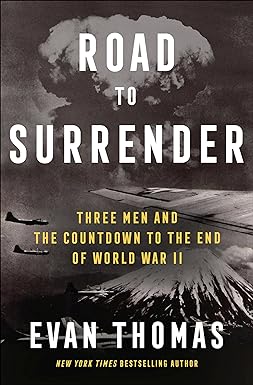
I put this book on my "Get At Library" list thanks to a good review in the Wall Street Journal. The reviewer, Michael Auslin, was right: it is really good. It's accessibly written; the author, Evan Thomas, was once a journalist at Time and Newsweek, and he knows how to tell a punchy story. But he's also a meticulous researcher, and it shows in the text, bibliography, and endnotes.
The "three men" of the subtitle: Henry Stimson, US Secretary of War under FDR and Truman; Shigenori Tōgō, Japan's Minister for Foreign Affairs; and Carl “Tooey” Spaatz, commander of the US Pacific air forces. There are, of course, many supporting characters; Thomas gets inside the heads of nearly everyone involved.
Thomas ably defends his major thesis: there was a good-faith argument that inflicting massive civilian casualties on Japan was necessary to avoid an even more massive bloodbath (on both sides) that would have resulted from an American invasion. He notes the intransigence of Japan's hardliners about surrender that continued even after the A-bombs were dropped. And even the eventual surrender was a near thing; there was an attempted coup against the pro-surrender forces. And there was a lot of seppuku.
Stimson, in particular, was tormented by the use of the A-bomb against Japanese cities. (He absolutely banned its use against Kyoto, a city he had previously visited, and charmed by its beauty.)
On the Japanese side, the focus on Tōgō is interesting too. He was kind of an oddball, marrying a German lady he'd met while on a diplomatic assignment there. Thomas makes clear that his advocacy of surrender was perilous: officials insufficiently gung-ho for war were often murdered.
Interesting fact: while the new B-29 bombers could fly at 30,000 feet, their ground speed on the way to Japan was greatly reduced thanks to the jet stream. (Thomas claims that the jet stream was a "never-before-observed meteorological phenomenon"; Wikipedia disagrees.) This caused a strategy shift from high-altitude daytime "precision" bombing (which was beset by other problems) to nighttime lower-altitude incendiary bombing, causing firestorms and massive civilian death. This, after the British bombing of Dresden was widely deplored.
Further interesting fact: Stimson called for the abolition of submarines as a weapon of war as Hoover's Secretary of State in 1930; too sneaky! And (as noted) he was morally torn about Hiroshima and Nagasaki. But in 1966, the USS Henry L. Stimson ballistic missile submarine was commisioned, carrying 16 Polaris/Poseidon/Trident missles, with warheads that made the bombs dropped on Japan look like relative firecrackers.
![[The Blogger and His Dog]](/ps/images/me_with_barney.jpg)



